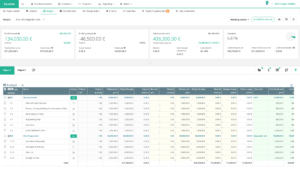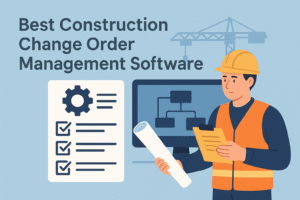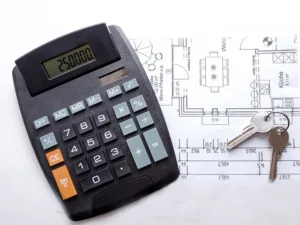The construction industry often deals with complex billing that involves multiple stakeholders, change orders, and project milestones. Inefficient billing can cause problems like cash flow issues, payment delays, and disputes. However, the proper construction billing software can help overcome these challenges by enhancing efficiency, accuracy, and profitability.
In this article, we’ll delve into the various types of construction billing, examine the essential elements, discuss common challenges, and outline the top ten best practices you should implement.
Table of Contents
What is Construction Billing?
Construction billing is the process by which clients are charged for work completed on a construction project. This involves preparing and sending invoices that cover services provided, materials used, and other costs incurred throughout the project. These invoices usually detail the expenses, outline the payment terms, and provide any other important information.
Effective construction billing is crucial for managing a construction project’s finances and ensuring profitability. It also plays a vital role in maintaining positive client relationships by transparently communicating the project costs.
Types of Construction Billing
In the construction industry, contractors use various billing methods to charge clients for work completed and materials provided. Here’s a look at some of the most common construction billing methods:
- Lump-Sum Billing Method: Also known as fixed-price billing, this method involves charging a set amount for the entire project. The contractor and client agree on the total cost before starting the work. This method is often used for smaller projects or those with clearly defined scopes.
- Time and Materials Billing Method: Known as T&M billing, this approach charges based on the actual time spent on the project and the materials used. Contractors invoice clients for the hours their team works and for materials, usually at an hourly rate. This method is ideal for projects where the scope might change, or the final cost is unpredictable.
- Cost-Plus Billing Method: In cost-plus billing, clients are billed for the actual costs of the project plus an agreed-upon fee or percentage that covers the contractor’s profit. This billing is transparent since clients pay for actual costs incurred. It’s suitable for projects with many uncertainties or scope variations.
- Progress Billing Method: This method involves billing based on completing predetermined milestones or stages within the project. Contractors invoice clients for parts of the total project cost as each milestone is completed, as agreed upon beforehand. Progress billing helps maintain steady cash flow and is often used in larger or longer projects.
- Retainage Billing Method: With retainage billing, a certain percentage of the contract value is withheld by the client until the project is complete or certain milestones are met. Contractors bill for the project minus the retainage at each milestone, with the withheld amount released upon project completion or when specific conditions are met.
- Unit Price Billing Method: This method charges based on the quantity of work completed or the number of units produced. Contractors set prices for specific tasks or items and bill accordingly. It is commonly used for projects that involve repetitive or standardized tasks like road construction or utility installations.
Contractors must choose the correct billing method based on the project’s specifics, including its nature, complexity, and contract details. Sometimes, a combination of billing methods is necessary to accurately capture the work done and to ensure fair payment. Effective and transparent billing practices are crucial for smooth project management, building strong client relationships, and achieving successful financial outcomes in the construction industry.
Essential Elements of the Construction Billing Process
In the construction industry, the billing process is complex and crucial for ensuring transparent and accurate invoicing, effective financial management, and successful project outcomes. Here are the key components that form the backbone of this process:
- Cost Estimation: This step involves calculating the anticipated costs for each aspect of the project, including labor, materials, equipment, subcontractor fees, and other related expenses. Accurate cost estimation is vital for setting appropriate billing amounts and ensuring the project remains profitable.
- Progress Measurement: It is essential to keep track of the completion status of different project segments. This helps contractors determine the amount of work completed for billing purposes. Accurate progress measurement is critical to producing invoices reflecting the project’s progress.
- Change Order Management: During construction, project specifications often change, leading to adjustments in scope, specifications, or conditions. Effective management of these changes ensures that all alterations and associated costs are documented and included in the billing, helping to avoid disputes and ensure all work is billed correctly.
- Billing Terms and Documentation: This involves defining the agreement between the contractor and the client regarding how often billing occurs, the terms of payment, and the preferred billing methods. Clear documentation is crucial as it ensures both parties understand and agree on the billing process, which helps prevent misunderstandings and payment delays.
- Invoicing: Creating and sending invoices to clients for payment is a critical step. Invoices should detail the work performed during the billing period, including quantities, unit prices, total charges, and applicable taxes or discounts. They may also include supporting documents like timesheets and receipts for materials.
- Payment Tracking and Collection: This process includes monitoring the status of issued invoices, ensuring payments are received on time, and managing accounts receivable. Many contractors use construction billing software to keep track of due dates, send payment reminders, and maintain visibility into the collection process. Efficient payment tracking is essential for sustaining healthy cash flow and minimizing the risk of unpaid invoices.
- Reporting and Analytics: Finally, analyzing the financial performance of both individual projects and the construction business as a whole is important. Construction billing software often features tools for generating reports on billing status, revenue projections, payment history, and profitability, among other metrics. These reports are invaluable for assessing financial health, spotting trends, and making informed business decisions.
Understanding and implementing these components effectively can lead to more streamlined project management, improved client relationships, and enhanced financial success in the construction industry.
Common Challenges in Construction Billing
Construction billing involves complex processes that can sometimes lead to inefficiencies and disputes. Here are some frequent challenges encountered in construction billing:
- Change Orders and Variations: It’s common for construction projects to undergo changes due to design modifications, unexpected issues, or client requests. Handling these changes involves extra work, cost adjustments, and meticulous documentation, all of which can complicate the billing process.
- Inaccurate or Incomplete Documentation: Proper documentation is crucial for accurate billing. Missing information or errors in critical documents like timesheets, receipts for materials, or records of change orders can lead to disputes and payment delays.
- Manual and Paper-Based Processes: Many construction firms still use manual methods for their billing processes, which can be prone to errors and inefficient. Manual data entry and paper-based records can lead to lost documents, delays, and increased administrative work.
- Inefficient Communication and Collaboration: Effective communication and collaboration among all project stakeholders are vital for smooth billing. Delays and mistakes often occur when there’s a lack of real-time data sharing or when information shared among project managers, accounting teams, and clients is inaccurate.
- Complex Payment Terms: Construction payment arrangements can be intricate, involving retainage, milestone-based payments, or payments based on completion percentage. These arrangements can be challenging to manage, mainly when dealing with multiple projects simultaneously.
- Regulatory Compliance: Compliance with relevant regulations is mandatory in construction billing. This includes adhering to tax laws, contractual obligations, and industry standards, all requiring detailed knowledge and thorough record-keeping.
- Integration with Management and Accounting Systems: Construction billing systems are often not fully integrated with project management or accounting software, leading to inconsistencies and duplicated efforts. Effective integration is crucial for maintaining accurate and current billing records.
Addressing these challenges requires careful planning, the right technology, and clear communication, all of which are essential for improving the accuracy and efficiency of construction billing.
10 Best Practices for Construction Billing
To ensure a smooth construction billing process, it’s essential to adhere to best practices that enhance accuracy, efficiency, and transparency. Here are ten best practices to follow:
- Establish Clear Contracts: Create detailed construction contracts with your clients that outline billing terms, payment schedules, project milestones, and any specific requirements. A well-defined contract prevents misunderstandings and billing disputes.
- Accurate Cost Estimation: Proper estimation of project costs is vital for precise billing. Include all potential expenses such as labor, materials, equipment, subcontractor fees, and overhead. Update these estimates regularly to reflect any project changes.
- Maintain Organized Documentation: Keep thorough and well-organized documentation throughout the project. This should include timesheets, material receipts, change orders, and other relevant paperwork. Good documentation supports your billing and can be audited if necessary.
- Adhere to Billing Schedules: Send invoices according to the agreed-upon schedule. Delays in billing can lead to payment delays and negatively impact your cash flow. Consider using software to automate invoicing and streamline the process.
- Track Progress and Report Regularly: Monitor the project’s progress and produce detailed work-in-progress reports that match billing milestones. This ensures invoices reflect the actual work completed and maintains transparency with clients.
- Manage Change Orders Effectively: Meticulously Document all project scope changes, costs, and timelines. Get client approval for these changes and adjust billing accordingly to avoid disputes.
- Regular Reconciliation: Frequently reconcile billed amounts with received payments and project costs. This practice helps identify discrepancies or outstanding payments and ensures financial accuracy.
- Transparent Communication: Keep communication lines open with clients, especially about billing issues. Promptly address their questions or concerns and clarify any confusion about invoices to build trust and reduce conflicts.
- Invest in Ongoing Training: Stay current with industry best practices and regulatory changes affecting construction billing. Regular training for your billing team will equip them with the necessary skills and knowledge.
- Leverage Technology: Use construction-specific billing software, like Bauwise, to manage the billing process effectively.
By implementing these best practices, construction businesses can refine their billing operations, reduce errors, handle disputes more effectively, and enhance overall financial management. Good billing practices are crucial for maintaining healthy cash flow, positive client relations, and successful project completions.
FAQ
What is progress billing in construction?
Progress billing in construction is a payment method where the contractor is paid for the completed portions of the work at various stages throughout the project rather than receiving a single lump-sum payment at the end. This approach aligns payments with the progress of the construction work, offering several advantages:
- Cash Flow Management: This method allows the contractor to manage cash flow more effectively, as payments are received throughout the project, helping to cover ongoing costs.
- Reduced Risk: Progress billing reduces financial risk for the contractor and the client. The contractor can receive all the payments at the end of the project, and the client can ensure that the quality and timeline are met before making each payment.
- Motivation and Accountability: Regular payments can motivate the contractor to stay on schedule and meet project milestones. They can also hold the contractor accountable for maintaining the quality and pace of work.
- Flexibility: Billing can be adjusted based on changes in the project scope or unexpected issues that may arise during construction.
The process typically involves the contractor submitting periodic invoices, often monthly, based on the percentage of work completed during that period. These invoices are usually accompanied by documentation and progress reports to justify the claimed percentage completion. The client, often with the help of architects or project managers, reviews these submissions to verify the work’s progress before releasing the payment. This method is prevalent in large and complex projects where the construction timeline extends over a long period.
What is AIA billing in construction?
AIA billing in construction refers to a standardized method of progress billing using forms developed by the American Institute of Architects (AIA). This system is widely used in the construction industry, particularly in the United States, to facilitate the payment process between contractors and clients on construction projects.
The critical components of AIA billing include:
- G702—Application and Certificate for Payment: The contractor uses this form to request payment. It summarizes the total project cost, previous payments, current payments due, and the remaining balance. The contractor certifies that the amount requested is justified by the work completed and materials delivered.
- G703—Continuation Sheet: This form details the project’s line-item breakdown. It lists the scheduled values of different parts of the work, including the completed and stored materials, the percentage of completion, and the dollar amount for each part. This breakdown helps the client or architect verify the accuracy of the contractor’s billing against the work progress.
These forms help streamline the payment process by providing a transparent, organized approach to documenting and calculating the progress of a construction project. This standardization benefits all parties involved:
- Contractors and subcontractors can submit payment applications in a format familiar to most stakeholders in the construction industry, which helps speed up processing and reduce administrative burden.
- Due to the structured and detailed nature of the billing, clients and architects find it easier to review and approve payments.
AIA billing is especially useful in large projects where multiple stakeholders require regular updates and detailed accounting of the construction progress. It also supports transparency and helps resolve disputes by providing thorough documentation of every payment stage.
About the Author

Mikk Ilumaa
Mikk Ilumaa is the CEO of Bauwise, a leader in construction financial management software with over ten years of experience in the construction software industry. At the helm of Bauwise, Mikk leverages his extensive background in developing construction management solutions to drive innovation and efficiency. His commitment to enhancing the construction process through technology makes him a pivotal figure in the industry, guiding Bauwise toward setting new standards in construction financial management. View profile






